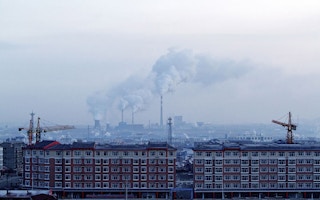It is 11:00 in the village of Nanxinzhuang, in the mountain range just west of Beijing. In the centre of the village, a group of young men are relaxing in the sun and chatting with passing schoolchildren who are heading home for lunch.
But nearby, farmer Wang Yongxian does not have time to relax. A severe shortage of water in the village means that tap water is provided for just four hours a day.
Mr Wang must fill pots and buckets with enough water for his wife and four-year-old granddaughter to use. He also needs water to irrigate his small patch of land, where he grows onions.
“When I was young, we had spring water to grow walnuts and pears,” the 60-year-old explained. But that changed when the spring dried up in the 1980s. Since then, the village’s ground water has also started to dry up, shrinking from seven wells to two.
“Drinking water has long been a problem for us, and we can’t grow crops. We’re dependent on the weather,” he explained.
Parched land
Wang Yongxian’s village lies in the heart of a large region of north-eastern China that is growing more desperate for water every year.
Millions are pouring into the capital, Beijing, and the neighbouring metropolis of Tianjin, leaving the provinces around those cities bone dry.
This arid region is on a par globally with chronically dry countries like Syria and Jordan, according to the United Nations Food and Agriculture Organisation.
China’s central government is hoping to ease the region’s water woes by turning to a resource right on their shores: salt water from the Bohai Sea.
Over the next five years, at least $3.3bn (£2.1bn) will be used to build desalination plants along the eastern coast.
The Chinese government has already invested tens of billions of dollars in other plans to solve the drought crisis, even redirecting water from China’s wet south to the parched north. However, that plan will only address part of the problem, leaving the authorities to search for additional fixes.
Desalination will triple the amount of processed seawater available for human use by 2015.
In a new industrial zone just outside Tianjin lies a desalination plant that is said to be a model for the rest. Built on the water’s edge, it is a hybrid desalination plan and power generator, both fuelled by coal.
At the moment, the desalination plant is only processing a fraction of what it could. Desalinated water from the plant costs 30% more than regular city water. Municipal buyers are not lining up to buy the plant’s water, though that is a temporary problem, explained Guo Qigang, the plant’s manager.
“Fresh water is one of our most important natural resources. If it is very scarce, it becomes indispensable,” he explained.
Tianjin, Beijing and the surrounding regions are so desperate for water, the reasoning goes, that it is inevitable that desalinated water will be necessary. The billions already spent on this plant are not a gamble, they are a sure-fire investment.
‘Quick fix’
And that is a disappointment to environmentalists who are critical of the concept of desalination.
“Desalination uses lots of energy to produce filters, and then to process and transport the clean water,” argued Zhang Junfeng, a Beijing environmental activist.
But the Tianjin plant is relatively environmentally friendly compared to other desalination technologies, said plant boss Guo Qigang.
“We produce drinkable water with a kind of recycling model,” he said. “Desalination uses the remaining heat from the power plant, so that it makes use of waste energy.”
Highly-concentrated salt water is usually a nasty by-product of the desalination process, but Mr Guo says that in Tianjin, the salt is processed into industrial grade salt.
But those green credentials don’t impress the environmentalist, Zhang Junfeng. Beijing and the surrounding region struggle with thick smog caused, in large part, by coal-fired power plants, so the prospect of new coal-dependent desalination plants along the coast is not a welcome one.
“Desalination is a quick fix solution,” he argued. “It is not encouraging people to conserve resources, but to find out how we can meet the consumption of resources.”
The farmer, Wang Yonglin, shrugs his shoulders when asked about the government’s plans to solve the water crisis. “I’m just an ordinary person,” he explained.
However, it is clear that he expects the officials at the helm in Beijing to address the resource crisis that is threatening his way of life.
For Mr Wang, and millions like him, the pressure is on the government to come up with a quick solution. Perhaps, then, it is no wonder the Communist Party has seized on desalination as a partial, albeit imperfect, solution.

















